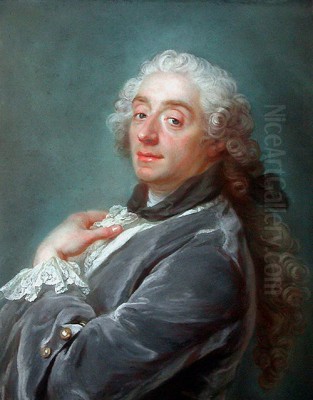
François Boucher stands as one of the most defining artists of the 18th-century French Rococo movement. His name is synonymous with the elegance, charm, and sensual lightness that characterized the high art of the era, particularly during the reign of Louis XV. A master painter, draughtsman, and etcher, Boucher's prolific output extended beyond easel paintings to encompass tapestry design, porcelain figures, stage sets, and book illustrations, making him a central figure not only in painting but in the broader decorative arts landscape of his time. His close association with the Marquise de Pompadour, the king's influential mistress, cemented his position at the apex of the French art world, yet his very success and style would later draw criticism as tastes shifted towards Neoclassicism. Understanding Boucher requires exploring his formation, his stylistic innovations, his key works, his patrons, his contemporaries, and the controversies that surrounded his celebrated career.
Early Life and Artistic Formation
François Boucher was born in Paris on September 29, 1703. His background provided a fertile ground for an artistic career; his father, Nicolas Boucher, was a painter and designer of embroidery and lace, giving young François early exposure to the visual arts and decorative crafts. Recognizing his son's burgeoning talent, Nicolas provided initial training. By the age of 17, François Boucher's promise was evident enough for him to enter the studio of François Lemoyne, a leading history painter of the time. Though his time with Lemoyne was reportedly brief, perhaps only a few months, the influence of Lemoyne's large-scale decorative style and light palette can be discerned in Boucher's later work.
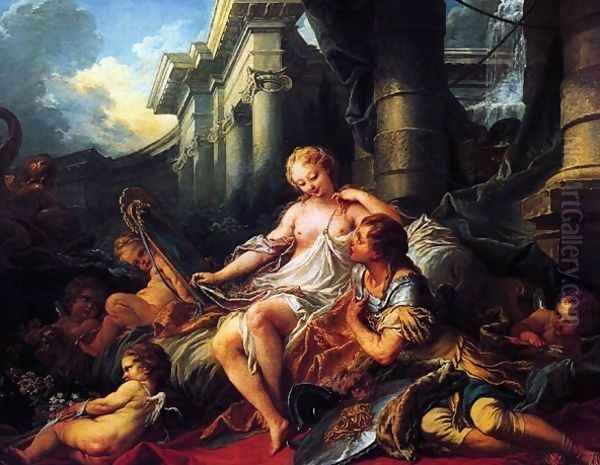
Following his stint with Lemoyne, Boucher found employment with the engraver Jean-François Cars, father of the engraver Laurent Cars who would later reproduce many of Boucher's paintings. In this workshop, Boucher honed his skills in drawing and printmaking. A significant early commission involved creating engravings after drawings by Antoine Watteau, the master of the fête galante style. This task, likely commissioned by Jean de Jullienne for the Recueil Jullienne, a large compendium of Watteau's works, immersed the young Boucher in Watteau's world of graceful figures, delicate landscapes, and themes of love and leisure, elements that would resonate throughout Boucher's own oeuvre.
In 1723, at the age of just 20, Boucher achieved a major milestone by winning the prestigious Prix de Rome, the premier art prize awarded by the Royal Academy of Painting and Sculpture. The winning work, Evilmerodach, son and successor of Nebuchadnezzar, freeing Jehoiachin, demonstrated his early mastery of history painting conventions. However, due to administrative issues or lack of royal funds at the Academy, he did not travel to Rome immediately. Instead, he continued working in Paris, producing paintings and engravings. It wasn't until 1727 that he finally made the journey to Italy, staying until 1731.
The Italian sojourn was crucial for broadening Boucher's artistic horizons. While there, he absorbed the influences of Italian Baroque masters, particularly the decorative brilliance of artists like Giovanni Battista Tiepolo, whose light-filled frescoes offered a parallel to the developing Rococo sensibility. He also studied the works of earlier masters such as Correggio and Veronese, known for their sensuous figures and rich color palettes. He was less drawn to the classical severity of Raphael or the dramatic intensity of Caravaggio, preferring instead the more decorative and painterly traditions that aligned with his own emerging style.
Rise to Prominence and the Rococo Style
Upon his return to Paris in 1731, Boucher quickly began to establish his reputation. He was formally accepted (agréé) into the Royal Academy of Painting and Sculpture in 1731 and achieved full membership (reçu) as a history painter in 1734 with his reception piece, Rinaldo and Armida. This marked his official entry into the highest ranks of the French art establishment. His ascent continued rapidly: he became an Academy professor in 1737, further solidifying his position within the institution that governed artistic production and taste in France.
Boucher's career coincided with the flourishing of the Rococo style, an artistic movement that emerged around the turn of the 18th century as a reaction against the formality and grandeur of the Baroque style associated with Louis XIV's reign. Rococo emphasized lightness, elegance, intimacy, and pleasure. It favored curving lines (rocaille), pastel colors, delicate ornamentation, and themes drawn from mythology, pastoral life, and intimate genre scenes. Boucher became arguably the most quintessential exponent of this style.
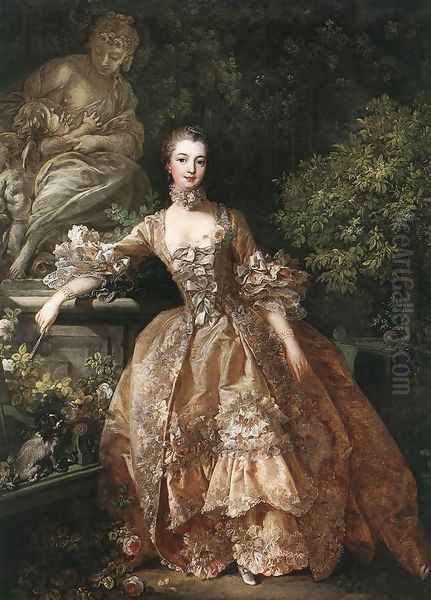
His paintings are characterized by their fluid brushwork, luminous and often pearlescent color harmonies (pinks, blues, pale yellows, greens), and compositions filled with graceful, curving forms. He excelled at rendering textures – the sheen of silk, the softness of flesh, the fluffiness of clouds. His subjects often revolved around themes of love, leisure, and beauty, frequently set in idyllic landscapes or opulent interiors. Mythological subjects, particularly those involving Venus, Diana, cupids, nymphs, and satyrs, were staples of his repertoire, treated not with solemnity but with a lighthearted, often sensual, charm. Pastoral scenes featuring idealized shepherds and shepherdesses in picturesque country settings were another favorite genre, reflecting an aristocratic fantasy of rural simplicity and romance.
Compared to his contemporary Jean-Baptiste-Siméon Chardin, whose quiet still lifes and scenes of bourgeois domesticity emphasized realism and moral virtue, Boucher's art celebrated artifice, sensuality, and aristocratic pleasure. While Antoine Watteau had pioneered the fête galante, imbuing it with a sense of melancholy and transience, Boucher's pastorals and mythological scenes are generally more overtly cheerful and decorative. He shared an interest in decorative compositions with Jean-Baptiste Oudry, known for his animal paintings and tapestry designs, but Boucher's range of subjects was broader and his treatment often more overtly sensual.
Major Works and Signature Themes
François Boucher's prolific output includes numerous masterpieces that exemplify his style and thematic concerns. Among his most famous works is The Bath of Diana (1742, Louvre Museum). This painting depicts the goddess Diana and a nymph after the hunt, resting by a pool in a lush landscape. The figures are rendered with Boucher's characteristic soft modeling and pearly skin tones, embodying Rococo ideals of feminine grace and beauty. The scene, while mythological, avoids high drama, focusing instead on intimacy and sensual repose.
Another iconic work is The Toilette of Venus (1751, Metropolitan Museum of Art, New York), commissioned by Madame de Pompadour for her Château de Bellevue. Here, the goddess of love is depicted amidst luxurious silks, flowers, and cherubic attendants, admiring herself in a mirror. The painting is a symphony of pastel colors, curving lines, and rich textures, epitomizing the Rococo fascination with beauty, luxury, and seduction. It perfectly encapsulates the intimate and ornamental aesthetic favored by the aristocracy.
Boucher was also a sought-after portraitist, particularly favored by Madame de Pompadour. He painted her numerous times, capturing her intelligence, elegance, and status as a patron of the arts. The full-length portrait of the Marquise de Pompadour (1756, Alte Pinakothek, Munich) shows her surrounded by books, musical scores, and drawings, emphasizing her cultural sophistication. Another famous portrait (c. 1758, Victoria and Albert Museum, London) presents her in a sumptuous green silk dress within an opulent interior. These portraits are less about psychological depth and more about celebrating the sitter's grace, fashion, and social standing.
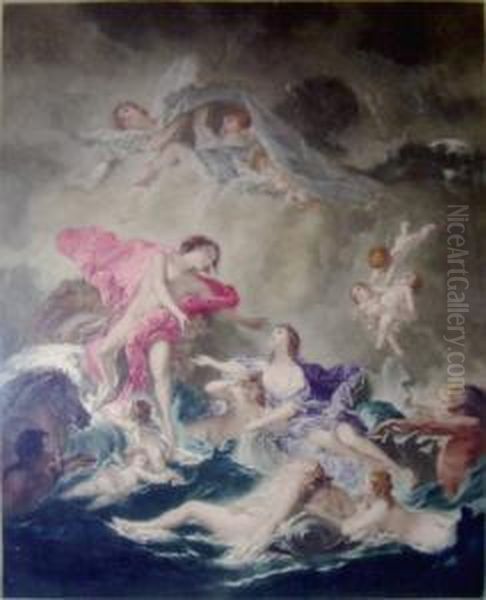
His large-scale decorative works are also highly significant. The Rising of the Sun and The Setting of the Sun (1753, Wallace Collection, London) were commissioned by Pompadour as full-scale cartoons for the Gobelins tapestry manufactory. These dynamic, swirling compositions depict Apollo, the sun god, beginning and ending his daily journey, surrounded by nymphs, tritons, and billowing clouds. They showcase Boucher's mastery of complex, multi-figure compositions and his ability to translate his painterly style into designs for other media.
Other notable works include pastoral scenes like Shepherd's Idyll (c. 1768, Metropolitan Museum of Art), allegories such as Allegory of Music (1764, National Gallery of Art, Washington), and intimate genre scenes like The Wooden Shoes (1768, Art Gallery of Ontario). Throughout these varied subjects, Boucher consistently applied his signature style: graceful figures, often with rosy complexions; light-filled, idealized settings; a palette dominated by blues, pinks, and whites; and an overall emphasis on charm, elegance, and sensual appeal. His depictions of playful putti (cherubs) became almost a trademark, appearing frequently in mythological and allegorical scenes.
The Patronage of Madame de Pompadour
No account of François Boucher's career is complete without acknowledging the pivotal role played by Jeanne Antoinette Poisson, Marquise de Pompadour. As the official chief mistress (maîtresse-en-titre) of Louis XV from 1745 until her death in 1764, Madame de Pompadour wielded considerable influence not only in politics but also in the arts. She was a woman of exceptional intelligence, taste, and ambition, and she became Boucher's most important patron and advocate.
Their relationship was mutually beneficial. Pompadour recognized Boucher's talent and his ability to create art that perfectly matched the sophisticated, pleasure-oriented tastes of the court. Boucher, in turn, found in Pompadour a discerning patron who provided him with prestigious commissions, financial security, and unparalleled access to the highest levels of French society. She commissioned numerous paintings from him for her various residences, including the Château de Bellevue and the Hôtel d'Évreux (now the Élysée Palace). These included mythological scenes, pastorals, allegories, and, of course, multiple portraits of herself.
Pompadour's support extended beyond direct commissions. She actively promoted Boucher's career within the royal establishment. It was largely through her influence that Boucher received key appointments, culminating in his designation as First Painter to the King (Premier Peintre du Roi) in 1765, following the death of Carle Van Loo, and his appointment as Director of the Royal Academy in the same year. These positions placed him at the very pinnacle of the French art world.
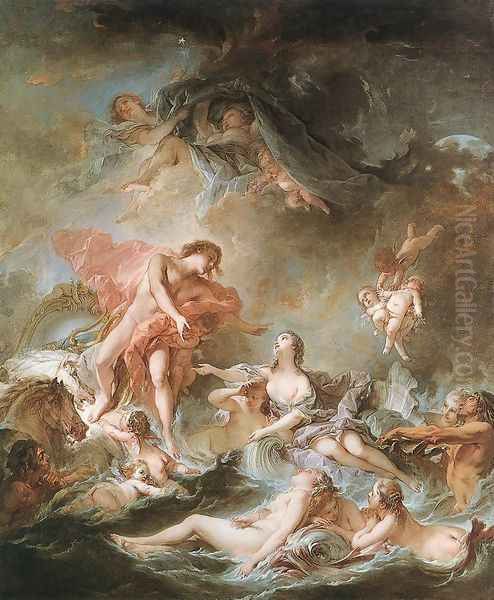
Madame de Pompadour was herself an amateur artist, practicing engraving under Boucher's guidance. This shared interest likely deepened their connection. Boucher's art came to define the "Pompadour style," characterized by its elegance, refinement, and intimate charm. Her patronage ensured that Boucher's Rococo aesthetic dominated French taste for nearly two decades. Her death in 1764 was a significant blow to Boucher, both personally and professionally, removing his most powerful supporter, although his official positions secured his status until his own death.
Versatility and Decorative Arts
François Boucher's influence extended far beyond easel painting. He was a remarkably versatile artist who engaged deeply with the decorative arts, reflecting the Rococo tendency to integrate art and design into a harmonious whole. His talents were sought after for a wide range of projects, demonstrating his adaptability and his central role in shaping the visual culture of the era.
One of his most significant contributions was in tapestry design. He worked extensively for both the Beauvais and Gobelins manufactories. For Beauvais, starting in the 1730s, he designed popular series such as the Fêtes Italiennes (Italian Festivals) and later the Histoire de Psyché (Story of Psyche) and the Amours des Dieux (Loves of the Gods). His designs, full of light, color, and graceful figures, revitalized the tapestry industry. His aforementioned Rising and Setting of the Sun for Gobelins are considered high points of 18th-century tapestry art.
Boucher also played a role in the Sèvres porcelain manufactory, which was under the patronage of Madame de Pompadour. While he may not have designed many specific models himself, his paintings and drawings frequently served as inspiration for the figural groups and painted scenes that adorned Sèvres porcelain. The delicate, pastel-colored figurines of shepherds, shepherdesses, and putti produced at Sèvres often echo the figures found in Boucher's works, translating his Rococo charm into three dimensions.
Furthermore, Boucher was active as a designer for the theatre and opera. He created elaborate stage sets and costumes that brought his painterly vision to life on the stage, contributing to the spectacular visual effects favored in 18th-century theatrical productions. His designs captured the fantasy and artifice inherent in both his paintings and the performing arts of the time.
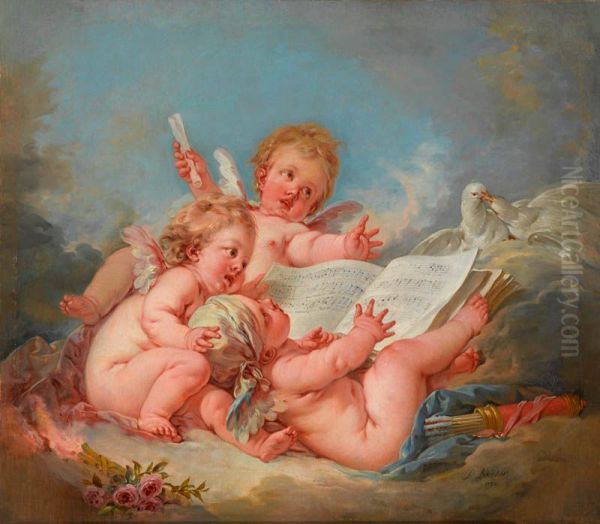
His work as a book illustrator should also be noted. Early in his career, he provided illustrations for editions of works by authors like Molière. These engravings demonstrate his skill as a draughtsman and his ability to adapt his style to the smaller scale and narrative requirements of illustration. This versatility across different media underscores Boucher's comprehensive engagement with the Rococo aesthetic and his impact on nearly every facet of visual production during his lifetime. His designs were widely disseminated through prints, further spreading his influence. Figures like the engraver Gilles Demarteau specialized in reproducing Boucher's drawings in the crayon manner, capturing their chalky texture.
Contemporaries, Influence, and Artistic Circle
François Boucher operated within a vibrant and complex artistic milieu in 18th-century Paris. His career intersected with those of many other significant artists, both as influences, rivals, colleagues, and mentors. His early engagement with the works of Antoine Watteau has already been noted. While Watteau's influence is undeniable, Boucher developed his own distinct, more robust and overtly sensual style. He also looked back to earlier masters, particularly Peter Paul Rubens, whose painterly dynamism and fleshy nudes found echoes in Boucher's work.
Among his contemporaries at the Royal Academy were prominent figures like Charles-Joseph Natoire, a rival in decorative painting, and Carle Van Loo, who preceded Boucher as First Painter to the King. Jean-Baptiste Oudry was another key figure, particularly in tapestry design and animal painting. Jean-Marc Nattier specialized in elegant court portraiture, often mythologizing his sitters, a practice Boucher also employed, especially for Madame de Pompadour.
Perhaps the starkest contrast among his contemporaries was Jean-Baptiste-Siméon Chardin. While Boucher depicted the idealized world of aristocratic leisure and mythology, Chardin focused on the quiet dignity of everyday life and the textures of humble objects. Chardin's work represented a different sensibility, one that gained favor with Enlightenment thinkers who criticized Boucher's perceived frivolity.
Boucher was also an influential teacher. He ran a busy studio and held a professorship at the Academy. His most famous pupil was Jean-Honoré Fragonard, whose own Rococo style, while indebted to Boucher's sensuality and painterly technique, developed a unique energy and expressive freedom. Other students included Pierre-Antoine Baudouin, known for his small, libertine genre scenes, who married Boucher's younger daughter, Marie-Émilie. Another daughter, Jeanne-Elisabeth Victoire, married Jean-Baptiste Deshays, another of Boucher's pupils who became a notable history painter before his early death. This network of students and family members extended Boucher's influence within the Parisian art world. His style impacted numerous lesser-known painters and decorative artists, making "Boucher-esque" a recognizable descriptor for a certain type of Rococo charm.
Criticism and Controversy
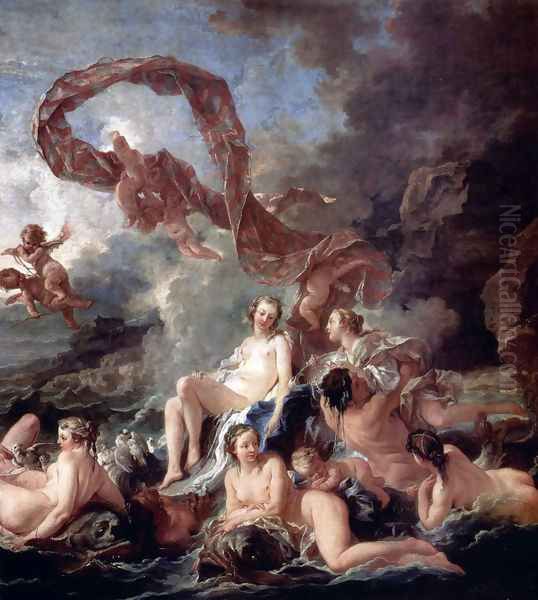
Despite his immense success and popularity, François Boucher was not without his critics, particularly as the intellectual climate in France shifted with the rise of the Enlightenment. The most vocal and persistent critic was the philosopher and art critic Denis Diderot. Reviewing the biennial Salons (official art exhibitions) for a private newsletter, Diderot repeatedly attacked Boucher's work, starting in the late 1750s and intensifying in the 1760s.
Diderot condemned Boucher on multiple grounds. He found his subjects, particularly the mythological nudes and pastoral scenes, to be frivolous, artificial, and morally corrupting. He accused Boucher of pandering to the decadent tastes of a corrupt aristocracy. Diderot famously wrote that Boucher's paintings displayed "imagination, effect, magic, and facility" but lacked truth, ideals, and dignity. He lamented Boucher's influence, claiming the artist degraded rather than elevated art. He criticized Boucher's color as unnatural ("What colors! What variety! What richness of objects and ideas! This man has everything except truth.") and his figures as mannered and lacking substance.
Diderot championed artists whose work he perceived as more truthful, natural, and morally uplifting, such as Jean-Baptiste Greuze, known for his sentimental and moralizing genre scenes, and Chardin, praised for his sincerity and realism. This critique reflected a broader Enlightenment desire for art that was rational, didactic, and connected to bourgeois values, rather than aristocratic fantasy.
As Boucher aged and his eyesight reportedly declined, some critics, including Diderot, claimed his technique became looser and his colors harsher, further fueling their disapproval. The growing taste for Neoclassicism in the latter half of the 18th century, with its emphasis on classical forms, historical themes, patriotism, and moral seriousness—exemplified by artists like Jacques-Louis David—also contributed to the decline of Boucher's reputation towards the end of his life and in the decades following his death. His art came to be seen by many as the epitome of the perceived decadence and superficiality of the Ancien Régime.
However, it's important to note that Diderot's criticisms, while influential, represented a specific viewpoint. Boucher retained powerful patrons and widespread admiration throughout his career. His commercial success remained significant, with his works commanding high prices. The controversy surrounding him highlights the shifting artistic and philosophical currents of the 18th century and the complex relationship between art, patronage, and ideology.
Later Life and Legacy
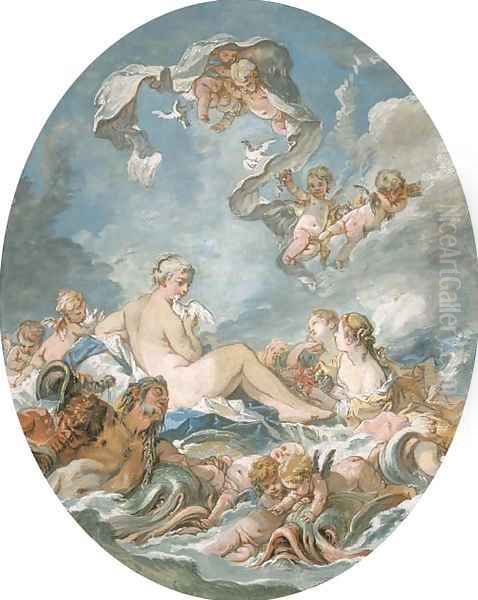
Despite the growing criticism from Enlightenment circles, François Boucher's official career reached its zenith in his later years. In 1765, he was appointed both Premier Peintre du Roi (First Painter to the King) and Director of the Royal Academy of Painting and Sculpture, the highest official positions available to an artist in France. These appointments confirmed his preeminence within the established art system, even as new aesthetic trends began to challenge the dominance of the Rococo style he embodied.
He continued to paint prolifically in his final years, although some accounts suggest his health and eyesight were failing. His late works sometimes show a looser handling and a continued preference for mythological and pastoral themes, though perhaps with less of the vibrant energy of his middle period. He remained active until the end, reportedly working on a painting of Venus when he died in his studio at the Louvre (where prominent artists were granted apartments) on May 30, 1770, at the age of 67.
In the immediate aftermath of his death and during the French Revolution, Boucher's reputation suffered significantly. The Neoclassical movement, championed by David, held sway, and Rococo art was widely dismissed as frivolous and associated with the overthrown aristocracy. However, Boucher's artistic merits were never entirely forgotten. In the 19th century, particularly with the Goncourt brothers' writings championing 18th-century art, interest in Boucher and the Rococo revived. Artists and collectors began to appreciate anew his technical brilliance, his mastery of color and composition, and the undeniable charm and elegance of his work.
Today, François Boucher is recognized as a master painter and the quintessential representative of the French Rococo. His works are prized possessions of major museums worldwide, including the Louvre, the Wallace Collection, the Metropolitan Museum of Art, and the Frick Collection. While the criticisms regarding the sometimes superficial nature of his subjects remain part of his historical assessment, his skill as a painter, his influence on the decorative arts, and his role in defining the aesthetic of an era are undisputed. He captured the spirit of his age – its pursuit of pleasure, its love of elegance, its refined sensuality – with unparalleled grace and facility. His legacy lies in his vast body of work that continues to enchant viewers with its beauty and technical virtuosity.
Personal Life and Anecdotes
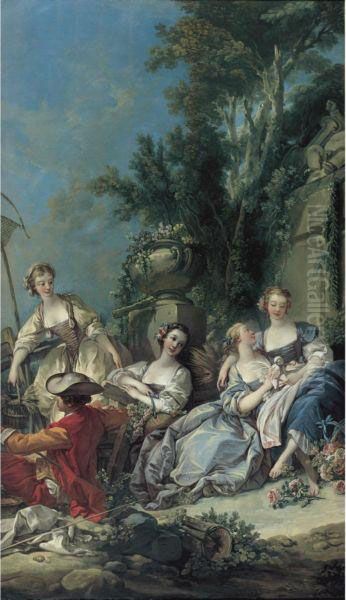
Beyond his public career and artistic output, glimpses of François Boucher's personal life offer further insight into the man and his times. In 1733, he married Marie-Jeanne Buzeau (or Buzot), who was herself reportedly a talented painter and engraver, occasionally exhibiting miniatures. She often served as a model for figures in his paintings. Their marriage seems to have been stable, and they had three children. As mentioned, two daughters married his pupils, creating a close-knit artistic dynasty. His son, Juste-Nathan François Boucher, also became a painter and architect.
Boucher appears to have enjoyed the comfortable lifestyle afforded by his success. He lived and worked in apartments in the Louvre, a privilege granted to esteemed artists. Accounts suggest he maintained a well-appointed studio and enjoyed socializing. An anecdote describes him hosting gatherings attended by nobles and elegant ladies, reflecting his integration into the fashionable society he depicted.
A notable story involves a trip Boucher took, possibly in the late 1750s or 1760s, with his friend and patron, the wealthy tax farmer (fermier général) Bergeret de Grancourt. Their journey, perhaps to Italy or within France, was recounted with humorous details about their shared adventures, looking at art collections, dealing with merchants, and enjoying the pleasures of travel. This suggests a capacity for friendship and enjoyment of life beyond the demands of his prolific artistic production.
Despite the attacks from critics like Diderot, Boucher seems to have maintained a degree of professional composure, continuing to fulfill commissions and uphold his official duties. His life spanned a period of immense cultural richness and shifting tastes in France, and he navigated this world with remarkable success, leaving behind an artistic legacy that defined an era. His personal life, intertwined with his patrons, family, and students, reflects the social and artistic networks that shaped the vibrant art world of 18th-century Paris.
Conclusion
François Boucher remains a towering figure in the history of French art. As the leading proponent of the Rococo style, he created a world of idyllic beauty, sensual pleasure, and decorative elegance that perfectly captured the spirit of the court of Louis XV and the tastes of patrons like Madame de Pompadour. His technical mastery—evident in his fluid brushwork, luminous color harmonies, and graceful compositions—was applied across an astonishing range of media, from monumental canvases and tapestry cartoons to intimate drawings and designs for porcelain and stagecraft.
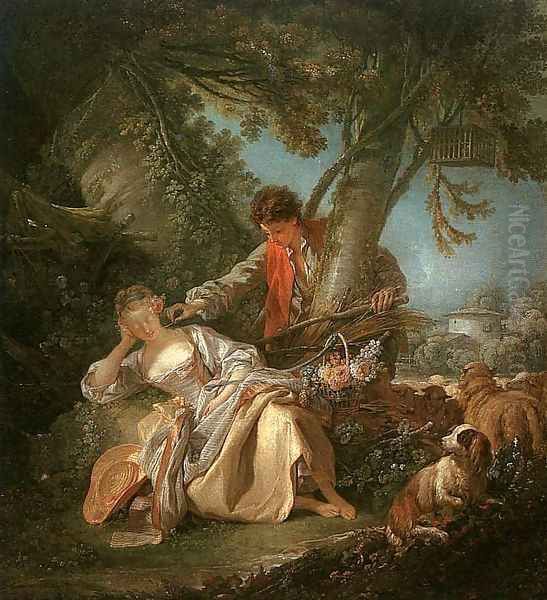
While his work faced significant criticism from Enlightenment thinkers for its perceived lack of seriousness and its association with aristocratic decadence, and while his reputation waned with the rise of Neoclassicism, subsequent generations have rediscovered and celebrated his artistic achievements. Today, Boucher is appreciated not only for his technical brilliance and aesthetic charm but also as a key figure whose art provides invaluable insight into the culture, values, and visual landscape of 18th-century France. He was, in essence, the master painter of Rococo grace, leaving behind a legacy of enchanting works that continue to captivate and delight.